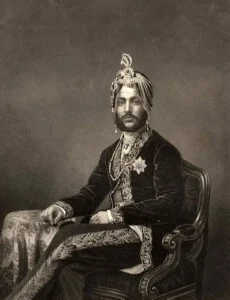The Rise and Fall of the Sikh Empire: Part 5 – The Fall of Sikh Empire

“The Anglo-Sikh Wars were not merely battles between two armies—they were the collision of two political worlds: the disciplined, but faction-ridden Khalsa army and the cold, calculating machinery of British imperialism. The valor of the Sikh soldiers earned even the grudging admiration of their enemies.”
History of Sikhs Vol. 1 & Vol. 2
Khushwant Singh
The Sikh Empire, forged by Maharaja Ranjit Singh, stood as one of the most formidable and prosperous states in South Asia. Under his leadership, Punjab transformed into a powerful, centralized state with a modernized military, a flourishing economy, and a culture of religious tolerance that set it apart from other regional powers. However, despite its strength and grandeur, the empire was ultimately fated to burn brightly but briefly.
The death of Maharaja Ranjit Singh in 1839, at the age of 58, marked the beginning of the empire’s decline. Without his unifying leadership, Punjab descended into chaos, political intrigue, and betrayal. Internal struggles, fueled by competing ambitions among nobles and the royal family, weakened the state’s ability to defend itself. Meanwhile, the British East India Company, which had long eyed Punjab as the last unconquered region in the subcontinent, patiently waited for the right moment to strike. The result was a series of events that led to the dismantling of the Sikh Empire, the exile of its last ruler, Maharaja Duleep Singh, and the tragic separation of his family.
The Death of Ranjit Singh and the Succession Crisis
On June 27, 1839, Maharaja Ranjit Singh succumbed to multiple health complications, leaving behind an empire at the peak of its territorial and economic strength. However, what he did not leave behind was a clear and uncontested heir who could maintain the stability of his kingdom. His death created an immediate power vacuum, plunging Punjab into a brutal and bloody period of political instability.
Ranjit Singh’s eldest son, Kharak Singh, ascended to the throne, but he was weak-willed and ineffective. His rule was short-lived, as his own ministers conspired against him, eventually poisoning him to death in 1840. His son, Nau Nihal Singh, became the next Maharaja, but his reign lasted only a few months before he was mysteriously killed when an archway collapsed on him—a suspected assassination orchestrated by rival factions within the royal court.
With the legitimate successors eliminated, the throne saw a rapid succession of weak and puppet rulers, controlled by power-hungry nobles, military generals, and courtiers. During this period, Punjab became a battlefield of intrigue and assassinations, further weakening the central authority that had once made it an indomitable force.

The First Anglo-Sikh War (1845-1846)
As Punjab remained embroiled in internal strife, the British East India Company found the perfect opportunity to intervene and exploit the disarray. With their well-trained armies and advanced weaponry, the British had already taken control of vast regions in India, and Punjab was the final frontier.
In 1845, under the pretext of political instability and the perceived threat posed by the Sikh army, the British provoked war. The First Anglo-Sikh War broke out, with fierce battles fought at Mudki, Ferozeshah, and Sobraon. Despite the unmatched bravery of the Khalsa Army, internal betrayals—particularly by Gulab Singh Dogra, a high-ranking noble who secretly aligned with the British—led to the Sikh defeat.
The war concluded with the Treaty of Lahore (1846), which stripped Punjab of key territories, including Jammu and Kashmir, which was sold to Gulab Singh Dogra for 7.5 million rupees, effectively making him a British ally. Additionally, the treaty forced Punjab to accept British residency, giving the East India Company direct influence over its administration.
The Second Anglo-Sikh War (1848-1849) and the Fall of Punjab
Although the British had subdued Punjab, they had not completely annexed it. However, unrest continued, and in 1848, revolts against British interference escalated into the Second Anglo-Sikh War. The battles of Ramnagar, Chillianwala, and Gujrat witnessed heroic Sikh resistance, but the empire was now fighting with depleted resources and divided leadership.
On March 29, 1849, the British secured complete victory, and Punjab was formally annexed into the British Empire. The once-great Sikh Empire had fallen, marking the end of independent Sikh rule in India.

The Fate of Maharaja Duleep Singh: The Boy King in Exile
At the time of the empire’s collapse, Maharaja Duleep Singh, the youngest son of Ranjit Singh, was merely eleven years old. As part of the British strategy to eliminate any chance of Sikh resurgence, they forcibly removed the young king from his throne. He was separated from his mother, Maharani Jind Kaur, the last queen of Punjab, who had been one of the most determined figures resisting British control.
Duleep Singh was taken under British custody and, in 1854, was sent to England, where he was raised as a Christian noble under Queen Victoria’s watchful eye. The British sought to erase his Sikh heritage, turning him into a symbol of the empire’s triumph. He was baptized into Christianity, stripped of his cultural identity, and molded into an English gentleman, living a life of privilege yet exile.
Meanwhile, his mother, Rani Jind Kaur, faced a tragic fate. Deemed a political threat, she was imprisoned and later exiled to Nepal. Her years in exile were filled with hardship, as she was kept under strict surveillance, and denied any contact with her son.
The Reunion of Duleep Singh and Rani Jind Kaur
After more than a decade of separation, Maharaja Duleep Singh finally learned the truth about his mother and his lost kingdom. In 1861, after persistent efforts, he was granted permission to meet Rani Jind Kaur in Calcutta (now Kolkata). Their reunion was emotional and deeply painful, as she revealed to him the extent of British deception and the true story of his stolen throne.
This encounter ignited in Duleep Singh a longing to reclaim his Sikh identity and lost heritage. Encouraged by his mother, he abandoned Christianity and sought to return to Punjab. However, the British, recognizing the potential danger he posed as a symbol of Sikh resurgence, closely monitored him and blocked his attempts to reclaim his kingdom.
The Tragic End of Duleep Singh and the Sikh Royal Family
After Rani Jind Kaur’s death in 1863, Duleep Singh’s efforts to return to India intensified, but each attempt was met with British opposition. Eventually, he was placed under house arrest in Europe. Broken, disillusioned, and financially strained, Duleep Singh died in Paris in 1893, never having set foot in his homeland again.
The fall of the Sikh Empire had not only resulted in the loss of Punjab’s sovereignty but also in the tragic displacement of its royal family. The British systematically ensured that no member of Ranjit Singh’s lineage could ever reclaim power, using exile, manipulation, and suppression to maintain their rule over Punjab.
The Legacy of the Sikh Empire
The fall of the Sikh Empire remains one of the most tragic yet significant events in Indian history. While its end was marked by political intrigue, betrayal, and British conquest, its legacy continues to inspire generations of Sikhs and Punjabis worldwide. The empire built by Maharaja Ranjit Singh stood as a testament to unity, tolerance, and strength, and its fall serves as a reminder of the consequences of division and external interference.
Even though Punjab was lost, the spirit of its people endured. The story of Maharaja Duleep Singh and Rani Jind Kaur stands as a powerful example of resistance, resilience, and the enduring bond between mother and son despite insurmountable odds. Today, the tale of the Sikh Empire’s rise and fall continues to be a defining chapter in South Asian history, shaping the identity of Sikhs and their global diaspora.
Link to blogs in this series:
- The Rise and Fall of the Sikh Empire: Part 1 – The Rise and Fall of Banda Bahadur
- The Rise and Fall of the Sikh Empire: Part 2 – Sikh Persecution
- The Rise and Fall of the Sikh Empire: Part 3 – Persian & Afghan Invasions
- The Rise and Fall of the Sikh Empire: Part 4 – The Rise of the Sikh Empire
- The Rise and Fall of the Sikh Empire: Part 5 – The Fall of Sikh Empire
References:
- The Sikhs by Khushwant Singh
- A History of the Sikhs: Volume 1: 1469by1838 by Khushwant Singh
- A History of the Sikhs: Volume 2: 1839by2004 by Khushwant Singh
- The Sikhs of the Punjab by J.S. Grewal
- The Fall of the Kingdom of Punjab by Khushwant Singh
- The Sikh Gurus by Dhillon Harish
- The Sikh World by Pashaura Singh & Arvind Pal Singh Mandair
👁️ 185 views


4 Comments on “The Rise and Fall of the Sikh Empire: Part 5 – The Fall of Sikh Empire”
Great commentary and a wonderful essay!
I enjoyed writing this series. And thank you for coming on this reading journey with me.
Glad you liked it.
Nice essay but many more insights and facts can be added.there was lot of Sikh struggle by many eminent Sikh leaders and preachers to bring back Maharaja Dilip Singh back.Group of Sikh leaders even went to London to bring him back,evidently he was baptised back to Sikhism by my great grandfather Gyani Partap Singh and he was one who preached him Sikhism
Thanks for the note, Ravi — and for sharing that fascinating family connection. You’re absolutely right, there’s much more that could be added, especially about the efforts by Sikh leaders and preachers to bring Maharaja Duleep Singh back to Punjab. The mission to London, his re-baptism into Sikhism, and the role of figures like your great-grandfather, who personally preached to him, are important parts of that history.
For this series, my goal was to create a concise timeline of events, which meant leaving out many such rich details to keep the length manageable (it’s already spread across five blogs). I had to cut out the whole section on General Hari Singh Nalwa, for example in part four of the series.
So, do keep a lookout for those. I do plan to revisit specific periods in future posts and dive deeper into stories like this one.
Please keep such notes coming. I appreciate your reading and engagement. Share the series within your network.